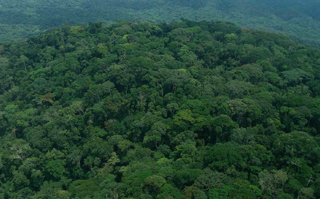Nature Study: Widespread Decline in Congo Rainforest Greenness Might Reflect Long-Term Drying Trend
ALBANY, N.Y. (April 23, 2014) -- New findings to be published in the May 8 issue of Nature points to a widespread decline in vegetation greenness and water content in the Congolese rainforest. The study, led by University at Albany Associate Professor Liming Zhou of Atmospheric and Environmental Sciences, found an extensive decline in satellite-detected forest greenness in the Congolese forests during the past 10-13 years. Further, this greenness decrease became broader in space and stronger over time.
The authors argue that the large-scale persistent browning of the Congolese forests, or loss of photosynthetic capacity, might reflect, at least partially, a slow adjustment to the long-term drying trend observed in central Africa, rather than a significant response to episodic events such as the recent severe short-term droughts in Amazonia in 2005 and 2010.
Read More: Potential Impacts of Long-Term Drought on Congo Rainforest
 |
|
The gradual loss of photosynthetic capacity and water content in the Congo over a long period might affect biodiversity of the rainforest, said Zhou.
|
"We found a gradually decreasing trend in satellite measured vegetation greenness and water content in the rainforest, instead of large-scale tree mortality as observed recently in the Amazon," said Zhou. "This widespread decline is generally consistent with the gradual temporal changes in moisture, vegetation and radiation parameters observed from several different satellites."
The implications for the study relate directly to the growing concerns of future climate change on rainforests in the tropical regions. Most climate models project increasing drought under global warming for the tropical rainforest regions.
"Under the stress of an increased severity of water deficit in a warmer and drier climate in the 21st century, the gradual loss of photosynthetic capacity and water content over a long period might alter forest species composition and structure and thus affect biodiversity and carbon storage of tropical rainforests," said Zhou. "For example, drier conditions may favor deciduous trees at the expense of evergreen trees."
The authors chose to study the central African rainforests, the second largest on Earth, in part because the forests have experienced a long-term drying trend whose impacts on vegetation dynamics remain mostly unknown since on-site observations have been very limited.
"Previous research used the satellite-measured vegetation greenness to investigate the effects of two severe short-term droughts in the Amazon rainforest, while little attention has been paid to African rainforest due the lack of ground measurements," noted Ranga Myneni at Boston University, a co-author of the study.
"The study is likely the most comprehensive observational study thus far exploring the effects of long-term drought on Congolese rainforests, involving analyses of several independent remote sensing products (optical, thermal infrared, microwave and gravity) over the Congo," added Yuhong Tian at I.M. Systems Group at NOAA’s National Environmental Satellite, Data, and Information Service (NESDIS), another co-author of the study.
Zhou and colleagues point out that more research needs to be done to better understand the impact of the loss of vegetation greenness. "This study provides observational evidence that helps to improve our understanding of how tropical forests respond to increasing drought. However, different plant species show different responses to climate change," said Zhou. "It's important to note that our assessment is just the first step. Full consideration of the vast and complex range of processes affecting different tropical rainforest species is needed to fully assess the future resilience of tropical forest."
This research involved a large, interdisciplinary and international team of researchers from several institutes. Other contributors include Philippe Ciais at Laboratoire des Sciences du Climat et de l’Environnement, France; Sassan Saatchi of NASA’s Jet Propulsion Laboratory (JPL); Yi Y. Liu at University of New South Wales, Australia; Shilong Piao at Peking University, China; Haishan Chen at Nanjing University of Information Science and Technology, China; Eric Vermote of NASA's Goddard Space Flight Center in Greenbelt (GSFC), Md; Conghe Song and Taehee Hwang at University of North Carolina at Chapel Hill, N.C.
![]() For more news, subscribe to UAlbany's RSS headline feeds
For more news, subscribe to UAlbany's RSS headline feeds
A comprehensive public research university, the University at Albany-SUNY offers more than 120 undergraduate majors and minors and 125 master's, doctoral and graduate certificate programs. UAlbany is a leader among all New York State colleges and universities in such diverse fields as atmospheric and environmental sciences, business, education, public health,health sciences, criminal justice, emergency preparedness, engineering and applied sciences, informatics, public administration, social welfare and sociology, taught by an extensive roster of faculty experts. It also offers expanded academic and research opportunities for students through an affiliation with Albany Law School. With a curriculum enhanced by 600 study-abroad opportunities, UAlbany launches great careers.


